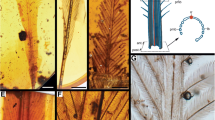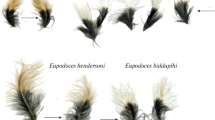Abstract
In the study reported here we explore a method for extracting information on the identity of fossil bird families from the fossil feather substructure and their possible taxonomic association with extant bird families. Such information can serve as an ecological indicator of the paleo-environment from which the fossil feathers have originated. It has been established that the balance between the water repellency and the resistance to water penetration of feathers can provide taxonomic information on bird families. These properties of feathers can be determined from the diameter of the barbs and their spacing, and their values correlate to the behavior/habitats of a large variety of families, particularly water bird families. The observed relationship between feather structure and habitat/behavior in extant water birds equally applies to fossil feathers and hence offers taxonomic clues about its avian bearer. The method is most productive for body feathers and limited to fossils of sufficient quality to permit evaluation in terms of barb diameter and spacing. The fossil feather collections of the Paleo-biology section of the Smithsonian Institution, Washington DC and the Senckenberg Research Institute and Natural History Museum, Frankfurt a/M were examined, and those specimens most amenable to quantitative evaluation were measured. The family relation of several specimens could be independently verified by the presence of additional anatomic material.
Zusammenfassung
Kann man aus der Unterstruktur von fossilen Federn taxonomische Informationen erschließen?
Wir untersuchen ein Verfahren, das Rückschlüsse auf die Identität fossiler Vogelfamilien zulässt. Dieses Verfahren basiert auf dem möglichen taxonomischen Zusammenhang zwischen der Federunterstruktur der fossilen und der gegenwärtigen Vogelfamilien. Die Verwandtschaft der Federunterstruktur kann als ökologischer Indikator dienen, um Rückschlüsse auf die paläozeitliche Lebenswelt, aus der die fossilen Federn stammen, zu ziehen. Es wurde gezeigt, dass der Zusammenhang zwischen Wasserabweisungsvermögen und Wasserdurchdringung der Federn die notwendigen taxanomischen Informationen liefert. Diese Federneigenschaften können aus dem Durchmesser und Abstand der Barben bestimmt werden. Die erhaltenen Werte korrelieren für ein breites Spektrum von Verhaltensweisen und Habitat, insbesondere im Bezug auf Wasservogelfamilien. Dieser beobachtete Zusammenhang zwischen Federstruktur, Verhaltensweisen und Habitat in heutigen Wasservögeln kann auf die Analyse fossiler Federn übertragen werden und erlaubt damit Rückschlüsse auf die Taxonomie der Vögel. Diese Methode ist vor allem zur Analyse von Körperfedern geeignet, und die Federnqualität muss ausreichen, um Durchmesser und Abstand der Barben zuverlässig zu bestimmen. Die Sammlungen fossiler Federn der Paläobiologischen Abteilung des Smithsonian Institute, Washington D.C (U.S.A.), und des Senckenberg Forschungsinstituts und Naturhistorischen Museums in Frankfurt a. M. wurden gesichtet und Federn mit ausreichender Qualität für die quantitative Untersuchung wurden dementsprechend vermessen. Die Verwandtschaft zwischen den Familien einiger Exemplare konnte anhand zusätzlicher anatomischer Information unabhängig von der Federnanalyse bestätigt werden.



Similar content being viewed by others
References
Baxter S, Cassie ABD (1945) The water repellency of fabrics and a new water repellency test. J Text Inst 36:T67–T90
Cassie ABD, Baxter S (1944) Wettability of porous surfaces. Trans Faraday Soc 40:546–551
Dove CJ (2000) A descriptive and phylogenetic analysis of plumulaceous feather characters in charadriiformes. Ornithol Monogr 51:1–163
Feduccia A (1999) The origin and evolution of birds, 2nd edn. Yale University Press, New Haven
Foth C (2012) On the identification of feather structures in stem-line representatives of birds: evidence from fossils and actuopalaeontology. Palaeontology 86:91–102
McKellar RC, Chatterton BDE, Wolfe AP et al (2011) A diverse assemblage of late cretaceous dinosaur and bird feathers from Canadian amber. Science 333:1619–1622
Olson SL (1977) A Lower Eocene frigatebird from the Green River Formation of Wyoming (Pelicaniformes: Frigitidae). Smithsonian contribution to paleobiology, vol 35. Smithsonian Institution Press, Washington DC, pp 1–33
Owre OT (1967) Adaptations for locomotion and feeding in the anhinga and double-crested cormorant. Ornithol Monogr 6:1–38
Rijke AM (1970) Wettability and phylogenetic development of feather structure in water birds. J Exp Biol 52:469–479
Rijke AM, Jesser WA (2011) The water penetration and repellency of feathers revisited. Condor 113(2):245–254
Rijke AM, Jesser WA, Mahoney SA (1989) Plumage wettability of the african darter (Anhinga melanogaster) compared with the double-crested cormorant (Phalacrocorax auritus). Ostrich 60:128–132
Robertson G (2002) Birds of a feather stick. Microscopic feather. Residues on stone artifacts from Deep Creek Shelter, New South Wales. Tempus 7:175–182
Stettenheim P (1972) The integument of birds. In: Farner DS, King JR (eds) Avian Biology, vol 2. Academic Press, New York, pp 1–63
Vinther J, Briggs DEG, Clarke J et al (2009) Structural coloration in a fossil feather. Biol Lett 10:1–4
Wuttke M (1983) Weichteil-erhaltung durch lithifizierte mikroorganismen bei mittel-eozänen vertebraten aus den ölschiefern der Grube Messel bei Darmstadt. Senckenberg Leth 64:509–527
Acknowledgments
The authors are indebted to the Smithsonian Institution, National Museum of Natural History, Washington, DC for help in the preparation of this study, specifically to Mark Florence for making the fossil feathers available to us, to Carla Dove and Scott Whittaker for their assistance with the measurements, to Chris Milensky for his help in procuring kingfisher feathers and to Storrs Olson and Helen James for suggestions and critical reading of the manuscript. The authors are most appreciative of the assistance they have received from the staff of the Senckenberg Research Institute, Frankfurt a/M, specifically from Anika Vogel, who created the high-quality images of the Messel specimens, and from Gerald Mayr for his valuable suggestions. All measurements were performed in accordance with the relevant laws pertaining to the USA and Germany.
Conflict of interest
None.
Author information
Authors and Affiliations
Corresponding author
Additional information
Communicated by F. Bairlein.
Rights and permissions
About this article
Cite this article
Rijke, A.M., Jesser, W.A. & Schaal, S.F.K. Can the substructure of fossil feathers provide taxonomic information?. J Ornithol 154, 663–670 (2013). https://doi.org/10.1007/s10336-013-0929-4
Received:
Revised:
Accepted:
Published:
Issue Date:
DOI: https://doi.org/10.1007/s10336-013-0929-4




